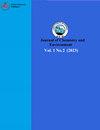Synthesis, characterization and antibacterial activity of ethylene di-amine and 2-hydroxybenzadehyde Schiff base and its metal complexes
引用次数: 1
Abstract
A number of modern techniques have been developed for the synthesis of Schiff bases. We reported the synthesis of ethylene di-amine and 2-hydroxybenzadehyde Schiff base (SB) via the condensation method. To remove phenolic hydrogen to form Schiff base it was reacted with sodium hydroxide and then treated with M(II) chloride (M=Fe, Cu, Zn, Ni and Sn) to fabricate their respective metal complexes. The synthesis of SB metal complexes and detailed functional group characterization were validated via Fourier transform infrared (FT-IR) spectroscopy. In the final SB, FT-IR results revealed a vibrational peak at 1614 cm-1, which was credited to the –C=N part. The absence of a vibration band for –OH vibration on 1613 cm-1 and the presence of a novel band in the 659 to 586 cm-1 range were due to the metal-oxygen bond, confirming the synthesis of metal complexes. The Schiff base showed high antibacterial activity against E. coli, Pseudomonas aeruginosa, Salmonella typhi, S.aureus and Bacillus whereas Streptococcus was found resistant. Cu, Fe and Sn coordination improved Schiff base activity while Ni coordination did not affect the activity. Similarly, Fe and Sn complex had no effect on E. coli. In comparison with standard Ciprofloxacin, the activities of respective metal complexes were low.乙烯二胺- 2-羟基苯甲醛希夫碱及其金属配合物的合成、表征及抑菌活性
许多合成希夫碱的现代技术已经发展起来。报道了乙二胺和2-羟基苯甲醛希夫碱(SB)的缩合反应。为了去除酚氢形成席夫碱,将其与氢氧化钠反应,然后用M(II)氯化物(M=Fe, Cu, Zn, Ni和Sn)处理,制备各自的金属配合物。通过傅里叶红外光谱(FT-IR)验证了SB金属配合物的合成和官能团的详细表征。在最后的SB中,FT-IR结果显示在1614 cm-1处有一个振动峰,这归功于-C =N部分。在1613 cm-1上没有-OH振动带,而在659 ~ 586 cm-1范围内有一个新的振动带,这是由于金属-氧键的存在,证实了金属配合物的合成。希夫碱对大肠杆菌、铜绿假单胞菌、伤寒沙门氏菌、金黄色葡萄球菌和芽孢杆菌具有较高的抑菌活性,而对链球菌具有耐药性。Cu、Fe和Sn配位提高了Schiff碱活性,而Ni配位对Schiff碱活性没有影响。同样,铁锡络合物对大肠杆菌没有影响。与标准环丙沙星相比,各金属配合物的活性均较低。
本文章由计算机程序翻译,如有差异,请以英文原文为准。
求助全文
约1分钟内获得全文
求助全文
来源期刊

Journal of Chemistry and Environment
Chemistry and Environmental Sciences-
自引率
0.00%
发文量
0
期刊介绍:
Journal of Chemistry and Environment (ISSN: 2959-0132) is a peer-reviewed, open-access international journal that publishes original research and reviews in the fields of chemistry and protecting our environment for the future in an ongoing way. Our central goal is to provide a hub for researchers working across all subjects to present their discoveries, and to be a forum for the discussion of the important issues in the field. All scales of studies and analysis, from impactful fundamental advances in chemistry to interdisciplinary research across physical chemistry, organic chemistry, inorganic chemistry, biochemistry, chemical engineering, and environmental chemistry disciplines are welcomed. All manuscripts must be prepared in English and are subject to a rigorous and fair peer-review process. Accepted papers will appear online within 3 weeks followed by printed hard copies.
Note: There are no Article Publication Charges. (100% waived). Welcome to submit your Mini reviews, full reviews, and research articles.
Journal of Chemistry and Environment aims to publish high-quality research in the following areas: (Topics include, but are not limited to, the following)
• Physical, organic, inorganic & analytical chemistry
• Biochemistry & medicinal chemistry
• Environmental chemistry & environmental impacts of energy technologies
• Chemical physics, material & computational chemistry
• Catalysis, electrocatalysis & photocatalysis
• Energy, fuel cells & batteries
Journal of Chemistry and Environment publishes:
• Full papers
• Reviews
• Minireviews
 求助内容:
求助内容: 应助结果提醒方式:
应助结果提醒方式:


